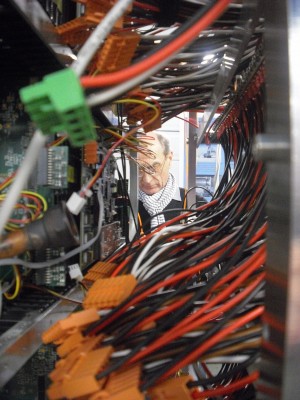
The Time Projection Chamber (TPC), pictured here in a test beam with researcher Leif Jönsson from Lund University, is one of the projects receiving funding from the German research ministry. Image: DESY
Thirty new active calorimeter layers, two engineering prototypes and some ten PhD theses – and that’s only part of the expected harvest of the recent funding approval for detector R&D targeted also towards the ILC in Germany. The German research ministry will support the universities of Bonn, Hamburg, Heidelberg, Mainz, Siegen and Wuppertal with 1.8 million Euros over the next three years. The money supports research cooperation between universities and research centres; in this case the Max Planck Institute for Physics and DESY.
“This is a very positive step forward for detector R&D in Germany. Our funding has doubled from the last funding period,” says Klaus Desch, professor at the University of Bonn and speaker of the research cooperation. The main focus is on instruments for future ILC detectors, but the results achieved and technologies tested are so versatile that they are used by other projects, including the CMS detector at the LHC, CLIC, the CAST experiment at CERN and even for medical imaging.
Of course the German groups are part of a larger R&D effort in international collaborations like CALICE and the LCTPC collaboration. After the funding period the investigators hope to have enough experience with the different technologies that they can select one and form collaborations to write the technical design report for a future ILC detector. “It may seem like a long time until the ILC will actually be built, but we need to develop large components very early – now – because their construction and in particular the required industrialisation for mass production will take a long time once approved,” explains Erika Garutti, University of Hamburg. “We need ten million SiPMs for one of the calorimeter types alone. In addition, wrapping ten million plastic tiles with reflector foil will require industrial-like procedures which will have to be developed by the university partners and transferred to companies.”
The specific tasks the six universities and two research centres have set themselves are to complete the technological prototype of the analogue hadronic calorimeter (AHCAL) for the ILD detector and to prioritise the various readout options for the ILD tracker, the time projection chamber or TPC. For the calorimeter, this means adding another 30 active detector layers to the existing four in the prototype of the AHCAL, studying technologies with regard to cost optimisation and mass production, and testing digital silicon photomultiplier. The TPC will benefit from advances in a novel, extremely granular readout scheme, dubbed the “Pixel-TPC”. Besides the development of the technology itself, simulations and prototype testing in the DESY test beam play an increasingly important role in order to optimise performance versus cost.
“We hope to get new international partners on board and count on the existing international R&D collaborations to continue the preparations for the ILC detectors – we need all hands on deck for a big and exciting project like the ILC,” says Klaus Desch.

Recent Comments